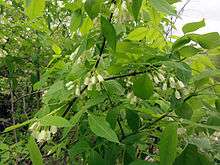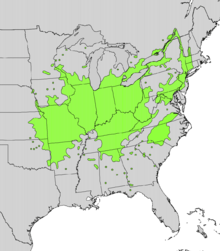Staphylea trifolia
Staphylea trifolia, the American bladdernut,[2] is native to eastern North America, from southern Ontario and southwestern Quebec west to Nebraska and Arkansas, and south to Florida. It is sometimes used as an ornamental plant.
| Staphylea trifolia | |
|---|---|
 | |
| Scientific classification | |
| Kingdom: | Plantae |
| Clade: | Tracheophytes |
| Clade: | Angiosperms |
| Clade: | Eudicots |
| Clade: | Rosids |
| Order: | Crossosomatales |
| Family: | Staphyleaceae |
| Genus: | Staphylea |
| Species: | S. trifolia |
| Binomial name | |
| Staphylea trifolia | |
 | |
It is a medium-sized shrub growing to 11 m (36 ft) tall.[3] Its growth rate is medium to fast. The leaves are opposite and divided into three leaflets, each leaflet 4.5–13 cm (2–5 in) long[4] and 5 cm (2 in) broad, with a serrated margin.[3] The leaves are bright green in the spring, turning dark green in the summer. S. trifolia produces pendant white flowers in spring, which mature into bladder-like, teardrop-shaped fruits that contain several large black seeds.[3] Some sources consider these "nuts" to be edible.
References
| Wikimedia Commons has media related to Staphylea trifolia. |
- Botanic Gardens Conservation International (BGCI).; IUCN SSC Global Tree Specialist Group. (2018). "Staphylea trifolia". IUCN Red List of Threatened Species. 2018: e.T135957125A135957127. doi:10.2305/IUCN.UK.2018-2.RLTS.T135957125A135957127.en. Retrieved 3 May 2020.
- "Staphylea trifolia". Natural Resources Conservation Service PLANTS Database. USDA. Retrieved 1 December 2015.
- Tenaglia, Dan. "Staphylea trifolia page". Missouri Plants. Missouri Botanical Garden.
- Brouillet, Luc (2014). "Staphylea trifolia". In Flora of North America Editorial Committee (ed.). Flora of North America North of Mexico (FNA). 9. New York and Oxford – via eFloras.org, Missouri Botanical Garden, St. Louis, MO & Harvard University Herbaria, Cambridge, MA.
This article is issued from Wikipedia. The text is licensed under Creative Commons - Attribution - Sharealike. Additional terms may apply for the media files.
